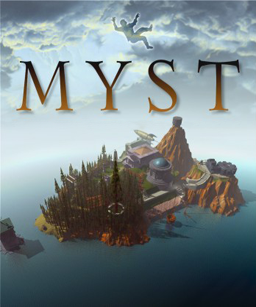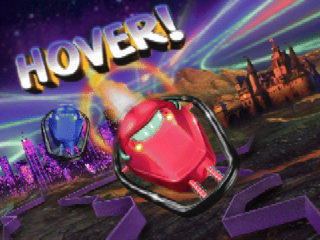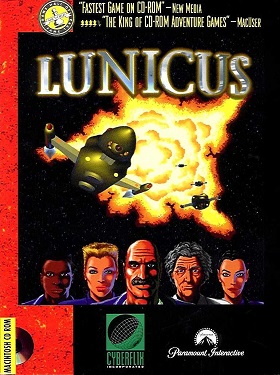
Hexen: Beyond Heretic is a fantasy first-person shooter video game developed by Raven Software and published by id Software distributed through GT Interactive on October 30, 1995. It is the indirect sequel to 1994's Heretic, and the second game in Raven Software's "Serpent Riders" trilogy, which culminated with Hexen II. The title comes from the German noun Hexen, which means "witches", and/or the verb hexen, which means "to cast a spell". Game producer John Romero stated that a third, unreleased game in this series was to be called Hecatomb.

Myst is an adventure video game designed by Rand and Robyn Miller. It was developed by Cyan, Inc., published by Broderbund, and first released in 1993 for the Macintosh. In the game, the player travels via a special book to a mysterious island called Myst. The player interacts with objects and traverses the environment by clicking on pre-rendered imagery. Solving puzzles allows the player to travel to other worlds ("Ages"), which reveal the backstory of the game's characters and help the player make the choice of whom to aid.

Adobe Shockwave is a discontinued multimedia platform for building interactive multimedia applications and video games. Developers originate content using Adobe Director and publish it on the Internet. Such content could be viewed in a web browser on any computer with the Shockwave Player plug-in installed. MacroMind originated the technology; Macromedia acquired MacroMind and developed it further, releasing Shockwave Player in 1995. Adobe then acquired Shockwave with Macromedia in 2005. Shockwave supports raster graphics, basic vector graphics, 3D graphics, audio, and an embedded scripting language called Lingo.

Titanic: Adventure Out of Time is a 1996 point-and-click adventure game developed by CyberFlix and published in the United States and United Kingdom by GTE Entertainment and Europress respectively, for Windows and Macintosh. It takes place in a virtual representation of the RMS Titanic, following a British spy who has been sent back in time to the night Titanic sank and must complete a previously failed mission to prevent World War I, the Russian Revolution, and World War II from occurring. The gameplay involves exploring the ship and solving puzzles. There are multiple outcomes and endings to the game depending on the player's interactions with characters and use of items.

Grolier was one of the largest American publishers of general encyclopedias, including The Book of Knowledge (1910), The New Book of Knowledge (1966), The New Book of Popular Science (1972), Encyclopedia Americana (1945), Academic American Encyclopedia (1980), and numerous incarnations of a CD-ROM encyclopedia (1986–2003).

Digital Pictures was an American video game developer founded in 1991 by Lode Coen, Mark Klein, Ken Melville, Anne Flaut-Reed, Kevin Welsh and Tom Zito.

ShadowCaster is a first-person role-playing video game developed by Raven Software. It was published in 1993 by Origin Systems after Electronic Arts acquired them. A CD-ROM version was released in 1994, featuring two additional levels with new monsters, and replacing text boxes with FMVs and spoken narration through CD-DA audio tracks.

Hover! is a video game that combines elements of the games bumper cars and capture the flag. It was included on CD-ROM versions of the Microsoft Windows 95 operating system. It was a showcase for the advanced multimedia capabilities available on personal computers at the time. It is still available from Microsoft. The game will not run on earlier versions of Windows.

CyberFlix Incorporated was a computer game company founded in 1993 by Bill Appleton. CyberFlix was based in Knoxville, Tennessee. They made many interactive story-telling games in the 1990s, but stopped any and all productions in 1998 before finally going out of business in 2006.
Gus Goes to Cybertown is a children's educational CD-ROM game released in 1993 by Modern Media Ventures. The main character is Gus, a talking and singing dog, who must find the three CyberBuds hiding in each of the town's five locations. Games are also hidden in each location, from spelling and number games to shape recognition and pattern matching games. Cybertown's park includes a timeline that shows Gus through time, from a Neanderthal to a futuristic spaceman. As the time changes, players can click on other items in the park to see them change as well. CyberBuds are revealed by interacting with various parts of each area. These characters will also provide tidbits of educational information. Upon completion of all in-game tasks, the player is treated to a final song on a "secret screen."

Lunicus is a 1993 computer game developed by Cyberflix and published by Paramount Interactive. It shares many traits in both graphical style and gameplay with some of Cyberflix's other games, like Jump Raven. It was rated as 1993 CD-ROM game of the year in the magazine MacWorld.

BBC Multimedia was a division of the BBC which dealt with the publishing of computer-game versions of well-known BBC television programmes.

JumpStart Kindergarten is an educational video game developed by Fanfare Software and released by Knowledge Adventure on the MS-DOS platform in 1994 (v1.0). It was the first product released in the JumpStart series and, as its name suggests, it is intended to teach kindergarten students. According to the Knowledge Adventure founder Bill Gross, it is the first educational software program that covers the entire kindergarten curriculum. It was ported to the Windows and Macintosh systems in 1995 (v1.2). It was updated with a new version on 24 November 1997 (v2.0). It was updated with additional content in a 2-CD Deluxe version in 2000 (v2.6), that included JumpStart Around the World. Eventually it was replaced in 2002 by JumpStart Advanced Kindergarten.
Andrew Nelson is a writer and professor living in New Orleans. He worked as a senior producer of Britannica.com, a creative director for Cyberflix, a visiting professor at Loyola University New Orleans, and a Public Relations and Social Media Account professional at Peter A. Mayer Advertising in New Orleans. Two computer games he developed for CyberFlix – Titanic: Adventure Out of Time (1996) and Dust: A Tale of the Wired West (1995) – were bestselling PC game and Macintosh Games of the Year. In 2007 he was awarded a Lowell Thomas Award for his work with the Society. He is a writer-at-large for Salon, National Geographic Traveler, ReadyMade, The New York Times, Via magazine, Weekend Sherpa and San Francisco Magazine.
William "Bill" Appleton is an American entrepreneur and technologist best known as the programmer of the first rich media authoring tool World Builder, the multimedia programming language SuperCard, a best-selling CD-ROM Titanic: Adventure Out of Time, the DreamFactory REST API platform, and Snapshot Org Management for Salesforce.
Hell Cab is a 1993 adventure video game developed by Digital Fusion and published by Time Warner in 1993 for Macintosh, Windows 3.x.

Chop Suey is a point-and-click adventure game developed and published by Magnet Interactive Studios for the Macintosh in 1995. It was developed by Theresa Duncan and Monica Gesue to be a story disc for girls. Art is by Ian Svenonius, music and sound is by Brendan Canty, and narration is by author David Sedaris.

Virtual Murder, renamed as Murder Mystery is a four-part murder mystery adventure video game series developed by Creative Multimedia Corporation. The games were released in 1993 and 1994 for Macintosh and Windows PCs.
Leonardo da Vinci is a 1997 interactive CD-ROM game by Corbis, consisting of a "computerized viewing tool which permits the user to examine English translations of the Codex [Leicester] superimposed onto facsimiles of its pages". The tool, known as Codescope, is licensed by Corbis.
Pyramid: Challenge of the Pharaoh's Dream is a 1996 education adventure game for Windows and Macintosh developed by Knowledge Adventure and published by Edusoft SA, published in Sweden by Knowledge Adventure and Levande Böcker.













